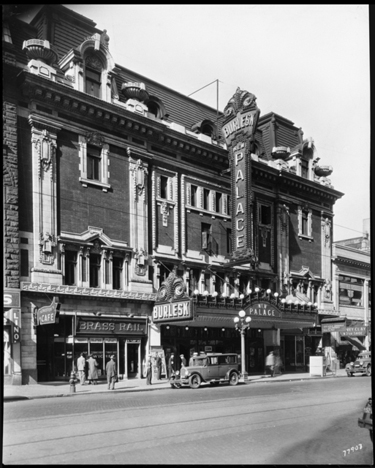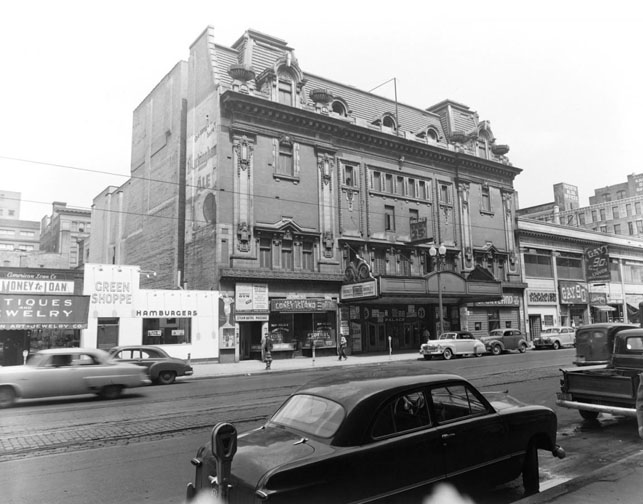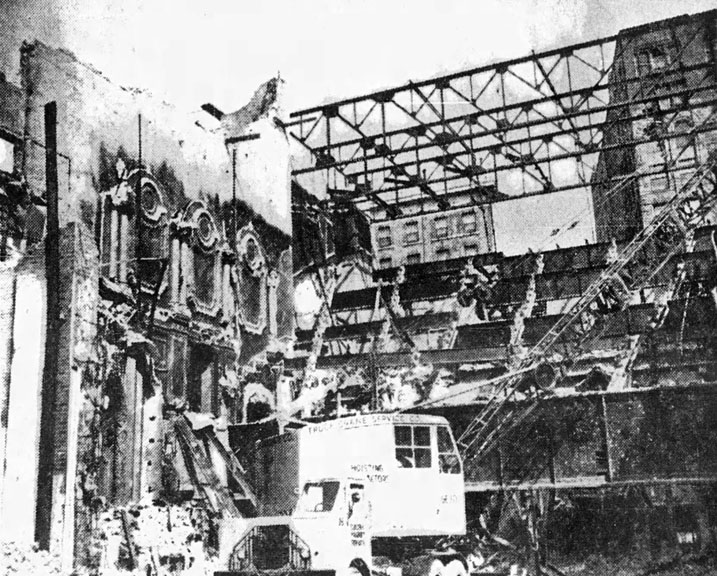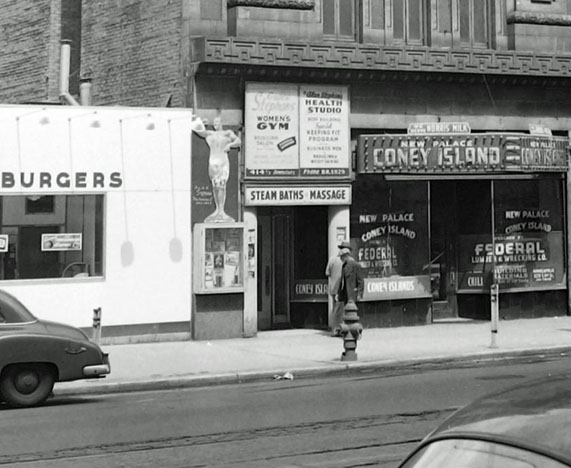Palace Theater
The Palace Theater was located at 414 Hennepin Ave.
The theater was built on the homestead of L.M. Stewart. See this page for much more interesting information on Stewart and his vast real estate holdings.
CONSTRUCTION
Excavation began on February 26, 1914, and it was front page news because Levi Stewart had been a longtime holdout, keeping his little cottage on prime Hennepin Ave. real estate. He died in 1910, and the land between 4th and 5th Street was finally ready for development. The theater was being built by the firm of Finkelstein & Ruben, which by 1914 operated at least six other theaters in the Twin Cities. It is interesting that in his review of opening night, Carlton W. Miles of the Minneapolis Journal gave Finkelstein & Ruben credit for having faith in the future of motion pictures to invest so much money into such a venture. Like so many things, there were people who thought that movies were a passing fad!
The Minneapolis Journal reported that on the first day of construction, 150 men and 50 teams of horses were on the job. S.J. Groves was doing the excavation, and the W.J. Hoy Company was the General Contractor. The architect was John Adolph Emil Eberson, with the assistance of the St. Paul firm of Buechner & Orth. (Larry Millett, Minneapolis Star Tribune, December 23, 2017)
The property was so well known that specific trees that were to fall were mentioned, almost by name. The excavators, doing the digging by horse and hand, were expected to reach the last cistern left in the business district – “a relic of the days when everybody collected rainwater for the Monday morning clothes washing.” (Minneapolis Journal, February 2, 1926)
The footprint of the building was 103′ x 157,’ as stated on the building permit, and although the permit estimated that the cost would be $150,000, the Tribune estimate that the cost upon completion would reach almost $600,000. Initial capacity was reported to be 2,400, but later reports mention 2,700 : 700 on the floor and the rest in three huge balconies.
SNEAK PEEK
The Minneapolis Tribune tells us that the new vaudeville house was made of Venetian red brick – a massive palatial building of stately lines – a towering pile of masonry and marble, of carving and casements, fashioned for the entertainment of men and women. Not a stick of wood has been used too reduce the threat of fire, and no patron was more than 25 feet from one of the 32 exits.
On the second floor there were two rooms for children: one for supervised play, and one for kids and/or mothers to nap. (The report in the October 6 issue of the Tribune cavalierly said that mothers “checked” their children like their coats and received them back upon presentation of their tickets.” The play area included a “heap of white sand,” a miniature train, teeter totter, or they could propel their own merry-go-round.)
On the other side of the building there was a “den” for men to smoke in a comfortable leather chair or settee, or toast their feet at a “chummy” fire if the weather is cold. (Minneapolis Tribune, August 30, 1914)
OPENING
The Palace Theater opened on October 5, 1914, and rave reviews were given by all of the local papers.
A review by Carlton W. Miles of the Minneapolis Journal described the finished Theater and its opening night in great detail.
If all the places of delight chronicled in the “Arabian Nights,” by the gentle Brothers Grimm and by Hans Christian Anderson were rolled into one big glitter, they would equal the dazzle of the New Palace theater, into whose shining shelter more than four thousand persons packed themselves for the formal opening last night.
Larry Millett provided this description:
The Palace . . . offered a sumptuous French Renaissance-style facade of Venetian red brick, complete with creamy terra-cotta trim and a mansard room sporting ornate dormers. Within, the lobby featured a sweeping marble staircase, arched ceilings, leaded glass windows and plenty of gilt plasterwork. (Minneapolis Star Tribune, December 23, 2017)
Mr. Miles of the Journal raved about the innovations detailed above, and all the “heavy glass electroliers” which are probably chandeliers in our parlance. Glitter, red curtains and rugs, and dazzle all impressed Miles. But he debunks the “not a stick of wood” claim when he tells us that the “smoking room” is paneled in Oak.
As for the program that opening night, the silent movie was Ethel Barymore’s first film, “The Nightingale.” The live vaudeville acts included:
- Cowboy Elliott and his his trained horse Don Fulamo
- Seymour and Robinson, aerobatics and comedy
- Curtis and Hebard, singing comedienes
- O’Neal and Walmsley, singing comedians
- Carl McCallough, impersonator
- Short films
- Frear, Baggoet, and Frear, juggler
Also in the house were Mayor Wallace G. Nye to welcome the Palace and its taxes to the City.
House Manager was Roy C. Jones. (Minneapolis Journal, October 6, 1914)
The house band was a local orchestra of eight pieces, led by Laugestett. A newspaper search finds no other references to Mr. Laugestett.
Succeeding ads seem to follow the formula of one film and five live vaudeville acts.
CHANGES
As grand as it was, the Palace faced stiff competition from the Orpheum, State, and Pantages Theaters, further up Hennepin Ave.
CinemaTreaures.org tells us that:
For most of the 1920s, the Palace Theater was operated by the Mutual Burlesk Company. Despite its name, it wasn’t a true burlesque house, in the later sense, but continued to screen movies and present stage shows.
Larry Millett:
In the mid-1920s, the Mutual Burlesk Co. took over management of the Palace, presenting a mix of movies and stage sows. Despite the company’s name, however, the Palace didn’t offer the naughty version of burlesque with scantily clad dancers.
CinemaTreaures.org:
In the late 1920s the Palace Theater closed, but was reopened shortly thereafter as a legitimate house.

Palace Theater, October 7, 1928. Photo courtesy Minnesota Historical Society
CinemaTreaures.org:
By 1934, under independent management, it was once again showing a mix of vaudeville acts and motion pictures, as in its early days. In the mid-1930s, the Palace Theater was the first major downtown house to present a double feature format, which continued through most of the rest of the decade.
Millett:
By the mid-1930s the theater had become a popular venue for wrestling.
In what probably does not rank as one of civilization’s great moments, on September 8, 1938, the theater offered “the first ice cream wrestling bout to be presented anywhere,” according to the Minneapolis Star. (September 6, 1938)
This epic encounter pitted experienced mud wrestlers Roughhouse Ross from St. Paul, against Jumping Joe Reno from New York, in a “sideboard ring” filled with 250 gallons of ice cream. It’s not known what flavor of ice cream was used or who won the match, but a crew from the Universal Newsreel was supposedly on hand to film the slippery action.
On November 26 and 27, 1938, new cowboy star Roy Rogers appeared onstage at the Palace Theater, with three singing cowboys. His first film, “Under the Western Sky” was premiered on the screen. (Minneapolis Star, November 24, 1938)
On May 4, 1939, wrestlers tangled in a vat full of molasses and popcorn – vying for the prize were Roughhouse Ross and Cowboy Watters. Mud wrestling rules applied.
CinemaTreaures.org reports that the Minnesota Amusement Company took over the theater in 1940 as a no-frills second-run house.
The Palace Theater’s last show was on May 11, 1953

Palace Theater, May 25, 1953. Photo courtesy Minnesota Historical Society
The Palace was razed during the summer of 1953 to make way for a parking lot.
The sad caption on the photo below reads:
Once a proud theater where some of the biggest names in show business of a bygone era appeared, the Palace theater, 414 Hennepin Avenue, is shown as the wrecking of the building nears completion. In this picture, which looks towards Hennepin Avenue from the alley behind the building, the crane stands where the stage once was located. The steel cross-beams held the gallery seats. The area where the building stands will be converted into parking lot when the wrecking job by the Federal Lumber and Wrecking Co. is finished. The job is expected to be completed by August 1. (Minneapolis Star, July 15, 1953)

Minneapolis Star, July 15, 1953
THE BASEMENT OF THE PALACE
Although the addresses are inconsistently given, it appears that there was a basement in the theater that was generally given the address 414 1/2 Hennepin Ave. That space grew from a lunch deli to a full-fledged night club during its 38 year existence. In the photo below, the end of the theater furthest away from 4th Street looks like it would have been the entrance to the basement. Those clubs are detailed on the Gay ’90s page.

